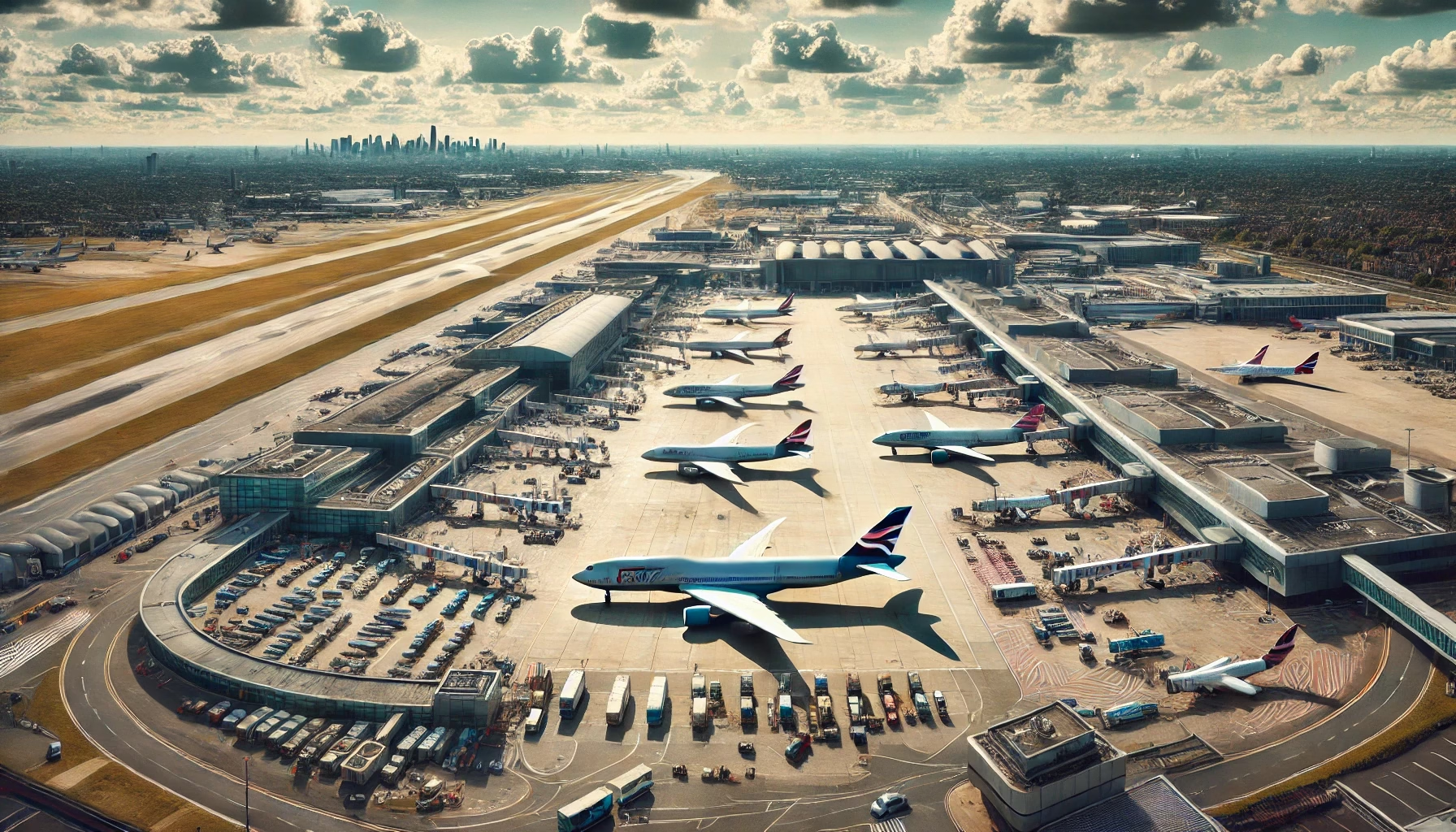Heathrow Airport stands as the United Kingdom’s busiest and most prominent international gateway, serving as a crucial link between Britain and the rest of the world. As Europe’s busiest airport and the fourth-busiest airport globally by passenger traffic, Heathrow plays a pivotal role in global aviation. With its extensive network connecting to 214 destinations across 84 countries, this aviation powerhouse facilitates travel, trade, and business on an unprecedented scale. In 2024, it achieved the distinction of being the most internationally connected airport in the world, cementing its status as a global aviation hub of immense importance.
The Rich History of Heathrow Airport
Heathrow’s story begins in 1929, when British engineer and aircraft builder Richard Fairey purchased a 150-acre plot of land in the village of Harmondsworth for £15,000. The site, initially called Great West Aerodrome, consisted of a single grass runway and a few small buildings used for assembling and testing aircraft. This humble beginning would eventually transform into one of the world’s most significant transportation hubs.
During World War II, the British government requisitioned Fairey’s airstrip and the nearby village of Heath Row, from which the airport later derived its name. The Royal Air Force renamed it RAF Heston and began developing it as a base for long-range military aircraft. New runways and a control tower were constructed to replace the original rudimentary setup, setting the stage for future expansion.
When the war ended in 1945, the RAF no longer needed the facility, and it was transferred to the Air Ministry as a civil airport. On January 1, 1946, it was officially opened as London Airport, launching its first passenger flight that day – a converted bomber aircraft named “Starlight” that flew to Buenos Aires, a journey that took 35 hours and required three refueling stops. This inaugural flight marked the beginning of Heathrow’s role in connecting Britain to the wider world.
The early passenger experience at Heathrow was quite different from what travelers encounter today. The first terminals were actually ex-military marquees that formed a tented village along the Bath Road. These makeshift facilities were surprisingly comfortable, featuring floral-patterned armchairs, settees, and tables adorned with fresh flowers. Passengers walked on wooden duckboards to protect their footwear from the muddy airfield when boarding aircraft. While there was no heating in these tents (making winters particularly challenging), during summer months the marquee walls were removed to allow for natural ventilation.
By the end of its first year of operation, approximately 63,000 passengers had traveled through London’s new airport. This number increased dramatically to 796,000 by 1951, necessitating more permanent facilities. British architect Frederick Gibberd was commissioned to design permanent buildings, creating a central area accessed via a “vehicular subway” running underneath the original main runway. The focal point of Gibberd’s design was a 122-foot-high control tower that would become an iconic part of the airport’s early infrastructure.
The original airport layout featured six runways arranged in three pairs at different angles, forming a hexagram pattern with the permanent passenger terminal in the middle. This innovative design ensured that two runways would always be within 30° of the wind direction, an important consideration for the aircraft of that era when crosswind landings were more problematic than they are today.
The airport continued to evolve throughout the following decades:
- By 1961, the old terminal on the north side had closed, and airlines operated from either the Europa terminal (later renamed Terminal 2) or the Oceanic terminal (now Terminal 3).
- Terminal 1 opened in 1969, by which time five million passengers were passing through annually as the jet age arrived with Boeing 707s, VC10s, and Tridents transforming commercial aviation.
- The 1970s marked the arrival of Concorde and wide-body jets like the Boeing 747, dramatically increasing passenger capacity. By the end of the decade, 27 million passengers were using Heathrow annually.
- Terminal 4 opened in 1986 to accommodate growing demand for international travel.
- Terminal 5, one of the world’s most advanced airport terminals, opened in 2008 after years of planning and construction.
- Terminal 1 was closed in 2015 to allow for the expansion of Terminal 2, streamlining operations.
By the time Heathrow celebrated its 60th anniversary in 2006, it had handled approximately 1.4 billion passengers on over 14 million flights – a remarkable testament to its growth from a small airfield to a global aviation hub serving the world.
Heathrow Airport Today: Size, Scale and Infrastructure

Today, Heathrow Airport spans an impressive 1,227 hectares (approximately 12.14 square kilometers or 4.69 square miles), making it the largest of London’s six international airports. Located in the London Borough of Hillingdon, approximately 14 miles (23 kilometers) west of Central London, the airport has transformed dramatically from its humble beginnings to become a small city dedicated to air travel.
Runways
Heathrow currently operates with two parallel east-west runways, a significant change from its original hexagram layout with six runways. The northern runway measures an impressive 3,902 meters – equivalent to the length of 78 Olympic swimming pools. These two runways operate at over 98% of their capacity, handling approximately 480,000 movements per year – one of the highest utilization rates for any major airport globally.
From the air, remnants of the original runway configuration can still be seen, now incorporated into the airport’s extensive system of taxiways. This efficient use of limited space demonstrates the airport’s evolution to meet modern aviation demands while working within geographical constraints. The intense utilization of these runways is one of the primary reasons behind the push for expansion, as the current infrastructure leaves little room for growth or resilience when disruptions occur.
Terminals
The airport currently has four operational passenger terminals, numbered 2, 3, 4, and 5. Each terminal has its own unique characteristics and serves different airlines and alliances:
Terminal 2 (The Queen’s Terminal): Reopened in 2014 after a complete rebuild, Terminal 2 serves as the home for Star Alliance airlines and several other carriers. The modern facility replaced the original Europa Building, which was Heathrow’s first terminal, bringing state-of-the-art amenities and increased capacity to this part of the airport.
Terminal 3: Originally opened as the Oceanic Terminal in 1961, Terminal 3 primarily handles long-haul flights and serves as a hub for Virgin Atlantic and many Oneworld alliance members. Its central location in the airport makes it convenient for connections but also means it experiences some of the highest passenger volumes.
Terminal 4: Opened in 1986, Terminal 4 is home to many SkyTeam alliance airlines and several Middle Eastern and Asian carriers. It’s connected to the central terminal area by free shuttle buses and the Underground’s Piccadilly Line, offering a slightly more separated experience from the busier central terminals.
Terminal 5: Opened in 2008 after a £4.3 billion investment, Terminal 5 is primarily dedicated to British Airways operations. The terminal consists of a main building (Concourse A) and two satellite buildings linked by an underground people mover system. With an area of 300,000 square meters in the main terminal building alone, T5 is equivalent in size to 50 football pitches. It has been voted the World’s Best Airport Terminal and features state-of-the-art facilities, including numerous lounges and extensive shopping and dining options.
There is no Terminal 1 anymore – it closed in 2015 to allow for the expansion of Terminal 2. Interestingly, rumors persist about a “secret” sixth terminal that allegedly serves VIPs, including royalty, heads of state, politicians, and certain celebrities, though official confirmation of such a facility is limited. This exclusive terminal would provide privacy and specialized security for high-profile travelers away from the public terminals.
Transport Connections
Heathrow’s strategic importance is supported by excellent transport links to London and beyond:
Heathrow Express: This high-speed rail service connects the airport to London Paddington station in just 15 minutes, making it the fastest route to central London. Trains run every 15 minutes, providing a premium option for time-sensitive travelers.
London Underground: The Piccadilly Line serves all terminals, offering a more economical route into the city, though with a journey time of approximately 45-60 minutes to central London. This option is particularly popular with budget-conscious travelers and airport staff.
Road Connections: The airport is accessible via the M4 motorway, which connects to the M25 London orbital motorway. Terminal 5 has its own dedicated motorway spur linking it to the M25 (between junctions 14 and 15), facilitating smoother access for vehicles.
Bus and Coach Services: Numerous local and national bus and coach services operate from Heathrow, connecting the airport to destinations throughout the UK and providing essential public transportation options.
Heathrow Pod: A personal rapid transit system connecting Terminal 5 to its business car park, representing innovative sustainable transport technology that reduces the need for shuttle buses on this route.
The airport’s infrastructure continues to evolve, with ongoing investments to improve passenger experience, operational efficiency, and environmental performance. These developments reflect Heathrow’s commitment to maintaining its position as a world-class aviation hub despite the constraints of its existing site.
Traffic and Connectivity at Heathrow Airport
Heathrow Airport’s traffic statistics underscore its significance on the global aviation stage. In 2024, it holds the distinction of being the busiest airport in Europe, the fourth-busiest airport in the world by total passenger traffic, and the second-busiest airport globally by international passenger traffic. Perhaps most impressively, it ranks as the airport with the most international connections in the world, making it a crucial nexus in the global air transport network.
Passenger Numbers
The record year for passenger traffic at Heathrow was 2019, when 80.9 million travelers passed through its terminals. This remarkable figure represents approximately 220,000 passengers per day – equivalent to the population of a medium-sized city moving through the airport every single day. To put this in perspective, on its busiest days, Heathrow handles more people than many towns have residents, processing them through check-in, security, immigration, and boarding with remarkable efficiency.
The COVID-19 pandemic significantly impacted these numbers, but the airport has been steadily recovering. In 2021, amid global travel restrictions, Heathrow still managed to serve 19.4 million passengers, of which 17 million were international travelers and 2.4 million were domestic passengers. This resilience speaks to the airport’s fundamental importance in maintaining global connectivity even during unprecedented disruptions to international travel.
Airlines and Destinations
Heathrow serves as a crucial global connector, with 84 airlines operating flights to 214 destinations across 84 countries. British Airways dominates operations at the airport, running approximately half of all flights. As Heathrow’s primary hub, British Airways benefits from the connectivity that allows it to offer an extensive global network, supporting its position as the UK’s flag carrier.
Virgin Atlantic also uses Heathrow as its main operating base, offering flights primarily to long-haul destinations. Together with numerous international carriers, these airlines create a vibrant aviation ecosystem that connects the UK to virtually every corner of the globe, from major business centers to leisure destinations.
The busiest single destination in passenger numbers is New York, with over three million passengers flying between Heathrow and JFK Airport in 2021 alone. Other popular routes include Dubai, Madrid, Amsterdam, and Singapore, reflecting both business and leisure travel patterns. This diverse mix of destinations highlights Heathrow’s dual role in serving both business travelers and tourists, contributing to its consistently high passenger numbers.
Hub Operations

Heathrow’s status as a hub airport is central to its operation and economic importance. As a hub, it can attract transfer passengers who connect between flights, allowing airlines to offer a wider range of destinations at higher frequencies than would be possible with point-to-point traffic alone. This model is particularly vital for long-haul routes that might not be sustainable based solely on origin-destination traffic.
This hub-and-spoke model enables Heathrow to support routes that might not be viable based solely on origin-destination traffic, creating a network effect that benefits both airlines and passengers. For UK travelers, this means direct access to a vastly greater range of international destinations than would otherwise be available from a single airport.
The connectivity provided by Heathrow is particularly valuable for business travelers, who often prioritize frequency, reliability, and network breadth when choosing their travel options. This business traffic, in turn, supports the extensive long-haul network that makes Heathrow such a vital international gateway. The airport’s role in facilitating global business has made it an irreplaceable asset in the UK’s economic infrastructure.
Economic Impact of Heathrow Airport
Heathrow Airport serves as a powerful economic engine for the United Kingdom, generating substantial benefits that extend far beyond its physical boundaries. The airport’s contribution to the national economy comes through multiple channels, including direct employment, supply chain effects, tourism facilitation, and enhanced business connectivity that supports international trade.
Direct Economic Contribution
Aviation plays a vital role in supporting economic growth across the UK, contributing approximately £14 billion to the nation’s GDP in 2023 and supporting over 140,000 jobs across the country in 2022. As the UK’s primary international airport, Heathrow accounts for a significant portion of this impact, serving as a cornerstone of the national aviation industry.
Within the airport’s boundaries alone, approximately 76,000 people are employed, making it one of the largest employment centers in the United Kingdom. These jobs span a wide range of sectors, including airline operations, retail, security, ground handling, maintenance, and administration. The airport creates opportunities for workers with diverse skill sets, from entry-level positions to highly specialized technical roles.
The third runway expansion proposal is expected to create up to 60,000 additional jobs during construction, followed by approximately 8,000 new permanent positions at the airport by 2030. The multiplier effect of these jobs would bring significant benefits to West London and the broader economy, stimulating growth in supporting industries and services.
Trade and Cargo Operations
Perhaps one of Heathrow’s most overlooked yet crucial roles is its function as the UK’s largest port by value. Despite handling far fewer tonnage than maritime ports, the high-value nature of air cargo means Heathrow facilitates over £200 billion worth of British trade annually – an astonishing figure that underscores its importance to the national economy.
The airport handles approximately 1.7 million metric tonnes of cargo each year, connecting UK businesses to 218 destinations worldwide. This cargo operation is particularly important for time-sensitive shipments and high-value goods. In 2022, the top three exported products through Heathrow were medicine, salmon, and books, while the leading cargo destinations were the United Arab Emirates, China, and the United States.
Around 60% of the UK’s air freight passes through Heathrow, highlighting its critical importance to the nation’s trade infrastructure. This cargo connectivity directly supports British exporters and maintains supply chains for imported goods, including essential items like pharmaceuticals and precision manufacturing components that would be impractical to transport by sea due to time constraints or value considerations.
Business Connectivity Benefits
For businesses, Heathrow’s extensive network provides vital global connectivity that enhances the UK’s competitiveness on the international stage. The airport’s hub status allows it to support direct flights to major business centers worldwide, reducing travel time and facilitating face-to-face interactions that remain essential for many business activities despite technological advances in remote communication.
This connectivity helps London (and nearby counties) compete with other European cities for business investment, producing economic benefits that radiate throughout the UK. The government and business groups emphasize that maintaining and enhancing this connectivity is essential for the UK’s future prosperity, particularly in a post-Brexit environment where global trade relationships are being reconfigured.
The Airport Commission has estimated that the economic benefits of expanding Heathrow with a third runway could total £61 billion over 60 years. These benefits would come through various channels, including reduced fares, fewer delays, enhanced connectivity, and job creation. However, it’s worth noting that some economists contest these figures, suggesting the benefits might be overstated or might simply shift economic activity from other regions rather than creating entirely new growth.
The Passenger Experience at Heathrow Airport
Heathrow Airport has invested significantly in enhancing the passenger experience across its terminals, transforming what could be a stressful transit point into a retail, dining, and service destination in its own right. From luxury shopping to premium lounges, the airport offers amenities designed to meet the needs of its diverse international clientele while streamlining the essential processes of air travel.
Shopping and Retail
Heathrow’s retail offering has evolved to become one of the most impressive among global airports. The shopping experience varies by terminal, with Terminal 5 offering particularly extensive options, including high-end brands like Burberry, Cartier, Chanel, and Rolex alongside more accessible retailers. This diversity ensures that travelers across the budget spectrum can find shopping opportunities suited to their preferences.
The airport’s duty-free shopping is operated under the Heathrow Boutique brand, offering competitive pricing on fragrances, cosmetics, liquor, and tobacco products. For travelers looking to maximize value, Heathrow’s “Shop and Collect” service allows passengers departing from and returning to Heathrow to purchase items on their outbound journey and collect them upon their return, avoiding the need to carry purchases throughout their trip.
The retail strategy at Heathrow extends beyond mere convenience shopping to position the airport as a luxury retail destination in its own right. The terminals feature carefully curated collections and exclusive airport editions of popular products, encouraging travelers to include shopping as part of their journey rather than an afterthought.
Dining Options
Culinary options at Heathrow span from grab-and-go conveniences to fine dining experiences. Each terminal features a mix of familiar chains, local concepts, and establishments by celebrated chefs. Terminal 2, for instance, hosts The Perfectionist’s Café by Heston Blumenthal, while Terminal 5 features Gordon Ramsay Plane Food, elevating the airport dining experience beyond typical expectations.
The airport has made efforts to incorporate more healthful and diverse dining options in recent years, reflecting changing consumer preferences and the international nature of its passenger base. Travelers can find everything from traditional British pub fare to Asian cuisine, Mediterranean options, and specialized dietary offerings including vegetarian, vegan, and halal choices to accommodate various cultural and dietary requirements.
Time-pressed travelers appreciate the efficient service options, with many restaurants offering “15-minute menus” designed to provide a quality meal within the constraints of a tight connection. Meanwhile, those with more time can enjoy leisurely dining experiences comparable to those found in London’s city center.
Lounges and Premium Services
For premium travelers, Heathrow offers an extensive network of lounges across its terminals. British Airways operates several tiers of lounges in its home at Terminal 5, including the exclusive Concorde Room for first-class passengers and top-tier frequent flyers. Virgin Atlantic’s Clubhouse in Terminal 3 has earned accolades for its stylish design and comprehensive services including spa treatments and a full-service bar.
Third-party lounges, including those operated by Plaza Premium and No1 Lounges, offer pay-per-use access for travelers regardless of airline or class of travel, democratizing what was once an exclusive experience. These facilities provide a quiet space to work or relax, complimentary food and beverages, and often shower facilities for refreshing between long flights.
Beyond lounges, Heathrow offers premium services including:
- Fast Track security for eligible passengers
- Personal shopping assistants to help navigate the extensive retail offerings
- Meet and assist services for those requiring additional support
- Porter services to ease the burden of luggage transport
- Private suites for the most exclusive travelers seeking complete privacy
These services reflect Heathrow’s understanding that different travelers have varying needs and expectations from their airport experience, from the efficiency-focused business traveler to the luxury-seeking vacationer.
Special Facilities
Heathrow has worked to accommodate travelers with diverse needs. Family-friendly facilities include dedicated security lanes for families, baby changing rooms, and play areas for children in all terminals. For business travelers, work pods and free Wi-Fi throughout the airport enable productivity on the go, transforming waiting time into useful work time.
Wellness options have expanded in recent years, with spas, prayer rooms, quiet areas, and even a dedicated terminal for passengers with hidden disabilities such as autism, dementia, or anxiety disorders. The airport’s Special Assistance service provides support for passengers with reduced mobility, ensuring the airport remains accessible to all travelers regardless of physical limitations.
These thoughtful accommodations reflect Heathrow’s commitment to ensuring that all passengers, regardless of their specific needs or circumstances, can navigate the airport comfortably and confidently.
Technology and Innovation
The passenger experience at Heathrow increasingly incorporates technological innovations designed to streamline processes and reduce stress. Self-service check-in kiosks, automated bag drops, and e-gates at immigration control help manage passenger flow efficiently, reducing queues during peak times.
The Heathrow mobile app provides real-time flight updates, terminal maps, shopping information, and transport options. Digital wayfinding throughout the terminals helps passengers navigate what can be a complex environment, particularly for first-time visitors or those making connections between terminals.
Behind the scenes, sophisticated systems track passenger movements, baggage handling, and aircraft operations, allowing the airport to optimize resources and respond quickly to disruptions. These technologies represent significant investments aimed at enhancing both efficiency and the passenger experience.
These combined elements create an airport experience that goes beyond the functional role of facilitating travel to become a significant part of the journey itself. While Heathrow has faced criticism in the past for overcrowding and delays, investments in infrastructure and services have substantially improved the passenger experience in recent years, establishing new standards for what travelers can expect from a world-class hub airport.
Future of Heathrow Airport: The Third Runway
One of the most significant developments in Heathrow Airport’s history is currently taking shape: the proposed addition of a third runway, which would substantially increase the airport’s capacity and reinforce its position as a global aviation hub. This expansion plan has been decades in the making, facing numerous political, legal, and environmental hurdles along the way.
The Expansion Plan
The current proposal centers on building a new northwest runway and accompanying terminal facilities. This would increase Heathrow’s capacity from approximately 480,000 flights per year to around 720,000 – an increase of 50% that would allow the airport to handle up to 140 million passengers annually, compared to its current capacity of approximately 90 million. This dramatic expansion would help address capacity constraints that currently limit growth and occasionally lead to delays.
The technical aspects of the plan are complex and ambitious. The third runway would necessitate:
- Demolishing hundreds of homes in surrounding communities
- Diverting rivers to accommodate the new infrastructure
- Rerouting the M25 motorway between junctions 14 and 15 through a tunnel beneath the new runway
The scale of this infrastructure project cannot be overstated – it represents one of the largest transport developments in UK history. While the original cost projection was £14 billion, this figure will likely require reassessment after years of delays and planning modifications. In January 2018, Heathrow unveiled a modified option with the new runway 300 meters shorter than originally planned, potentially reducing costs from £16.8 billion to £14.3 billion while still delivering the needed capacity increases.
Recent Developments
In January 2025, Chancellor Rachel Reeves announced the government’s support for Heathrow’s expansion, framing it as part of Labour’s plans to stimulate economic growth. This support marks a significant shift, as many current government members, including Prime Minister Sir Keir Starmer, had previously voted against Heathrow expansion while in opposition.
Following this announcement, Heathrow’s CEO Thomas Woldbye confirmed that the airport would submit its plans for a third runway to the government by summer 2025. As part of a phased expansion program, Heathrow has also committed to a £2.3 billion investment plan to improve service, resilience, and passenger experience within the existing airport boundary as a pathway to the third runway.
The airport’s proprietors – which include sovereign wealth funds from Saudi Arabia and Qatar, as well as private equity firm Ardian – have indicated that the expenses associated with the expansion would be funded by fees imposed on airlines utilizing the enlarged facility. This financing approach has raised concerns among airlines already operating at Heathrow, who worry that increased fees might be passed on to passengers.
Timeline and Process
Even with governmental support, the journey to a third runway remains lengthy. The official planning phase could extend up to two years, followed by potential judicial reviews and the need to address environmental concerns raised by opponents. Local governments and residents will also have significant input through consultation processes.
Following these regulatory and planning phases, construction is projected to take an additional six to seven years. This suggests that if all proceeds according to current plans, the earliest the third runway might become operational would be around 2035 – a decade from now. This extended timeline reflects both the physical complexity of the project and the thorough scrutiny it will receive through planning and environmental assessment processes.
Economic Benefits vs. Environmental Concerns
Proponents of the third runway emphasize its economic benefits. The expansion could:
- Inject billions into the UK economy through increased trade and business activity
- Create over 100,000 jobs both directly and in supporting industries
- Strengthen Heathrow’s status as a global passenger and air freight hub
- Deliver benefits for passengers through lower fares and reduced delays
- Support UK exports and facilitate international business
- Help the UK compete with major European hubs that already have more runways
The Airport Commission’s 2015 evaluation suggested that Heathrow’s expansion could yield benefits totaling £61 billion over 60 years. Additionally, advancing the project would signal to international investors that the government is serious about prioritizing growth and infrastructure development.
However, the expansion faces significant opposition, particularly on environmental grounds. Critics argue that increasing aviation capacity would undermine the UK’s ability to meet its legally binding climate change obligations. London Mayor Sadiq Khan’s office has expressed longstanding opposition to airport expansions in London, citing concerns about air quality and noise pollution affecting surrounding communities.
The government has emphasized that any expansion must be delivered “in line with the UK’s legal, climate, and environmental obligations.” Efforts to develop sustainable aviation, including the recent Sustainable Aviation Fuel (SAF) Mandate that requires 2% of aviation fuel supply to come from sustainable sources this year (increasing to 10% by 2030 and 22% by 2040), are presented as ways to reconcile growth with environmental responsibilities.
The tension between economic development and environmental protection remains at the heart of the debate over Heathrow’s future, reflecting broader societal questions about how to balance growth with sustainability in a climate-conscious age.
Environmental Considerations at Heathrow Airport
As one of the world’s busiest airports, Heathrow faces significant environmental challenges and scrutiny. The airport’s operations impact local air quality, generate noise affecting surrounding communities, and contribute to the aviation sector’s carbon footprint. However, Heathrow has implemented various initiatives to mitigate these impacts while working toward more sustainable operations.
Noise Management
Aircraft noise represents one of the most direct environmental impacts on communities surrounding Heathrow. With flights operating from early morning until late evening, noise management is a critical aspect of the airport’s environmental strategy and community relations efforts.
Read more at worldsinsight.












One thought on “Heathrow Airport: The UK’s Premier International Gateway”